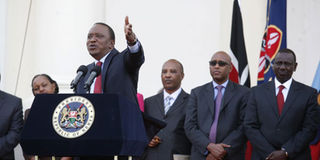Why Kenya must have new high-speed rail line

PHOTO | FILE President Uhuru Kenyatta flanked by Deputy President William Ruto and Cabinet Secretaries addressing the press on the Standard Gauge Railway project at State House, Nairobi on January 28, 2013.
What you need to know:
While it is proper and in the nation’s interest to have this debate, it obfuscates the SGR’s great potential as a catalyst for economic take-off in Kenya and the rest of East Africa.
Debate on the proposed standard gauge railway line between Mombasa and Nairobi, which is being implemented by the government, has largely been about the way the project was procured.
While it is proper and in the nation’s interest to have this debate, it obfuscates the SGR’s great potential as a catalyst for economic take-off in Kenya and the rest of East Africa.
It is, however, heartening to note that this fact was the crux of President Uhuru Kenyatta’s State of the Nation address, and especially his comments on the project.
The region continues to be an economic backwater, largely due to layer upon layer of systemic inefficiency. Regional businesses cannot operate and compete optimally.
The single most important factor that makes trade in East Africa an expensive affair and goods produced in the region uncompetitive is the cost of production, of which transport is a major component.
Out of every Sh100 that one pays for goods in Kenya, a material Sh45, nearly half the price, goes into paying for transport which, plainly put, means subsidising our inefficient transport network.
TRANSPORT COST
This is very steep compared to countries like China, Brazil, Russia and India, which have been able to manage this key variable and hold it at between five and 15 per cent of the cost of production.
As a result, some goods manufactured in these countries land in our shops much cheaper than what is produced here. Our companies cannot compete. Our brands cannot win even on their home turf.
An overstretched road transport can barely cope and is suffering severe wear and tear. A poorly serviced railway service, as it exists today, is not even an option worth talking about. Yet goods transport is best done by trains the world over.
By offering a viable alternative, the SGR will have done a lot to the Kenyan economy. Our competitiveness will grow and, as a result, Kenyan-made goods are likely to replace the foreign ones on our shelves. Many new, sustainable jobs will be created.
Kenya’s strategic location on the eastern seaboard of the Indian Ocean has placed it in a unique position as a gateway to the region. The Port of Mombasa has traditionally played this role, but its performance has been greatly stymied by the inefficiencies inherent in the transport systems of the rich and growing hinterland it serves, what is normally referred to as the Northern Corridor.
CARGO HAULAGE
This hinterland includes not just Kenya but Uganda, Rwanda, South Sudan, eastern DR Congo and potentially, Burundi and Ethiopia or at least huge swathes of these countries.
Under the Tripartite Initiative for Fast Tracking the East African Integration, Kenya, Uganda and Rwanda have lately done a lot to reduce inefficiencies and remove non-tariff barriers (NTBs) to trade on the main Northern Corridor from Kigali to Mombasa, but it is not enough. Only a seamless and efficient railway transport network can resolve the challenge of cargo haulage on the corridor.
Kenya cannot afford to rest on its laurels. The hinterland states are under no obligation to export and import their goods through Mombasa. Actually, the rate at which competing ports like in Tanzania (Dar es Salaam, Tanga and Bagamoyo) and Djibouti are improving their facilities and hinterland transport implies that if Kenya does not act fast, these countries will soon be eating our lunch.
Ethiopia is currently undertaking a massive and ambitious modernisation of its railway infrastructure, which could make Djibouti a better outlet for lucrative South Sudan oil.
Losing out would be disastrous for an economy in which 80 per cent of all commercial activity is built around the Northern Corridor.
At the micro-level, the SGR will spawn a lot of opportunities for Kenyans: jobs and businesses, during its construction. Besides those working on the project itself, there will be contractors providing such vital services as hospitality, entertainment, security and transport.
Few Kenyan engineers or technicians have hands-on experience in the actual building of a railway track, considering that, there has been no major physical addition to the line built by the colonialists over 100 years ago. The SGR presents a great opportunity for technology transfer.
The potency of the railway as a magnet for economic activity is evidenced by Nairobi itself. The city’s choice as capital city in preference over Machakos and growth as centre of commerce was greatly enhanced by its status as a railway hub.
Kenya’s urbanisation has been largely linear, along the railway line. The SGR line has the potential to once again liven up some moribund towns, infuse commerce into them and create more opportunities for the enterprising Kenyans.
Mr Mwania is a transport and logistics manager




